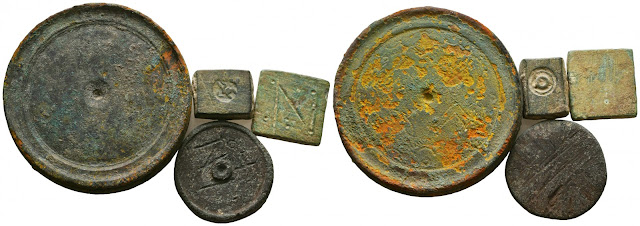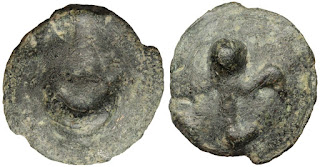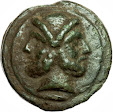Friday, March 11, 2022
ANA Money Show Finds
Monday, February 21, 2022
Byzantine Coin Weight with NH or 8 Nomisma
I picked up a lot of Late Roman or Byzantine coin weights today. New to me is an Eight Solidi / Nomismata (= 8/6ths of an Ounce) = 36.4 gr. std wt. It is engraved N֯H with a series of dots. There are 36 examples of this denomination on pondera. The lot also had 4 & 2 Solidi wts.
Shown below are some weights I obtained since my last coin weight post.
Late Roman or Early Byzantine bronze coin weight
NH – 8 Nomisma or Solidi
This weight was purchased as part of a lot of 3. When I have
the weight in hand, I will check weight and dimensions.
Obv – Centering indention between marks of value - N° H
decorated with swirled lines, all made with punched dots
Rev - Centering
indention
Edge to be determines, obv & rev have raised edges.
Late Roman / Byzantine coin weights used N֯H to indicate eight
Numis / Solidus. The standard weight is 36.4 g.
There are 37 (36 bronze) 8 N weights on -
https://pondera.uclouvain.be/browse/
Five Nomismata round coin weight, late Roman or Byzantine, 4th
to 6th century AD
Obv – Engraved circle between marks of value - N° E
decorated with swirled lines, all made with punched dots
Rev - Engraved circle
surrounded by 4 equally spaced dots
Edge had raised edges and center, obverse and reverse have
raised edges with inscribed circle.
22.42 grams
25 mm dia X 7 mm thick
same denomination as Bendall 96
Byzantine Octagonal Bronze Weight of 4 Numismata; 800 - 1000
A.D
Obverse - N֯Δ to indicate four Numis / Solidus
Reverse - blank
18.14 grams
22 X 21 X 5 mm
NΔ - 4 Nomisma or Solidi from NBS lot
Obv – Centering indention between marks of value - N° Δ decorated with swirled lines, all made with punched dots
Rev - Centering indention and 4 dots (weight adjustment?)
Edge to be determines, obv & rev have thick raised edges.
Three Nomismata round coin weight, Byzantine, 5th
to 6th century AD
Obv – Engraved circle between marks of value - Ν° Γ, above
cross all made with inscribed lines
Rev - Engraved circle
surrounded by 4 equally spaced dots
Edge had raised edges and center, obverse and reverse have
raised edges with inscribed circle.
13.1 grams
22 mm dia X _ mm thick
similar to Bendall 145
Geneva 262
Late Roman / Byzantine coin weights used N֯ Γ to indicate 3
Numis / Solidus. The standard weight is 13.6 g. Many weights, but not all, have
a small o near the N. There are 368 3 N weights on -
https://pondera.uclouvain.be/browse/
I also picked up some Greek lead weights.
Hellenistic lead weights, 8 Dracma?
Weight: 27,9 gr
Diameter: 50,6 mm
Hellenistic lead weights 4 Dracma?
Weight: 15,8 gr
Diameter: 34 mm
Hellenistic lead weights
Weight: 12,4 gr
Diameter: 40,7 mm
Four late Roman or Early Byzantine scale weights
ΓΓ – 3 Ounces or Uncia
NB – 2 (?) Nomisma or Solidi
N – 1 Nomisma or Solidi
Unknown denomination weight with mark on obverse and two
inscribed circles on reverse
Monday, January 3, 2022
Semuncia Crescent Thyrsus
I like these coins because they show the light and heavy weight series. I picked up one several years ago. I had to google Thyrse or Thyrsus or Thrysos: thyrsus: [noun] a staff surmounted by a pinecone or by a bunch of vine or ivy leaves with grapes or berries that is carried by Bacchus and by satyrs and others engaging in bacchic rites. merriam-webster
Aes Grave semuncia, APULIA, LUCERIA, AE 268-250 BC; note that this series is based on 10 VNCIA per Roman As (10 ounces per pound). There are two series. The heavier series is assumed older. Obv: Crescent; Rev: Thyrse adorned with a garland.
Apulia, Luceria, AE Aes Grave Semuncia, 268-250 BC D/ Crescent. R/ Thyrse adorned with a garland. H.pl. 71, 7-8; Syd., Aes Grave, 143 var.; T.V. 279; Vecchi 343. 19.20 grams (384 grams equivalent Libra) Green patina. Grading/Status: Fine - Very Fine; Elsen - Auction 147, Lot 270
Greek Italy. Northern Apulia, Luceria. AE Cast Semuncia, heavy series, 225-217 BC. Obv. Crescent. Rev. Thyrsus. HN Italy 675; Vecchi ICC 343. AE. 20.22 grams (404 grams equivalent Libra); 24.00 mm. R. Rare. About VF. Artemide Kunstauktionen e18; lot 22; 5/22/2021
Greek Italy. Northern Apulia, Luceria. Light series. AE Cast Semuncia, c. 217-212 BC. Crescent. / Thyrsus with fillets; in field, L. Vecchi ICC 350; HN Italy 677f. AE. 6.04 g. 19.00 mm. Lovely untouched earthen green patina. Good VF. Artemide LIV; lot 38; 11/7/2020
Italy. Northern Apulia, Luceria. AE Semuncia, 217-212 BC. Obv. Crescent. Rev. Thyrsus with fillets; in field, L. HN Italy 677f. TV 286. ICC 350. AE. g. 6.68 mm. 20.00 VF. Artemide 32e; lot 15; 1/23/2016


















